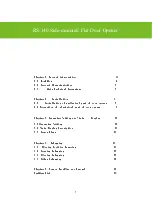
fig. 1
fig. 2
1 - 2°
fig. 8
fig. 7
1 - 2°
fig. 6
fig. 4
fig. 5
fig. 3
Fixing in figure 66
¾
Mark the fixing positions in accordance with fixing dimensions (see figure 1 and 2 above.) There are three holes to be
drilled/tapped on the door leaf for the closer body and four holes to be drilled/tapped on the underside of the transom
for the parallel arm bracket.
¾
Separate the primary and secondary arms. This can be done using a screwdriver as a lever. The arm sections will
snap together and apart. Secure the primary arm to the spindle using M6 allen bolt supplied. Ensure splines are
interlocked. Locate arm at approx. 10° towards the rear of the closer. (See figure 3 and 4.) Turn closing speed valve,
located on the front of the body of the closer fully clockwise. This will decrease the closing speed to almost zero.
Do
not overtighten
. Rotate primary arm to approximately 90°. (See figure 5 and 6.) Secure closer body to door leaf
with fixings provided, making sure that the spindle is positioned away from the hinge side. (See figure 1 and 2
above.) The power size (closing force) of the TS2000 is not adjustable in this configuration and the unit must be
mounted using the centre fixing holes. Secure primary and secondary arms together (simply click in place.)
¾
Rotate primary arm in direction of travel (away from door leaf) until an angle of approx. 2° is reached in relation to the
door leaf. (See figure 7 and 8.) Tighten 10mm locking bolt.
¾
TS4000 only.
If no latch action is required. Fit closer as described above. Separate the primary and secondary arms.
Turn closing speed valve, located on the front of the body of the closer fully clockwise. This will decrease the closing
speed to almost zero.
Do not overtighten
. Rotate the primary arm approx. 90° in the direction of travel (roughly
perpendicular to the door leaf.) Loosen the M6 allen bolt securing the primary arm to the closer body enough to
enable adjustment. Rotate the primary arm 1 notch of the splined spindle in the opposite direction of travel. Re-
tighten M6 allen bolt securing the primary arm to the closer body. Loosen 10mm locking bolt on secondary arm and
re-connect primary and secondary arms. Re-adjust the closing speed. Rotate primary arm in direction of travel (away
from door leaf) until an angle of approx. 2° is reached in relation to the door leaf. (See figure 7 and 8.) Tighten the
10mm locking bolt. If on testing the latch action has not been removed repeat above until adjusted satisfactorily.
¾
The
latch action of the TS4000DA can now be adjusted using the adjustment valve located on the front in the centre
of the body. Clockwise will decrease the latch action and anticlockwise will increase the latch action.
Do not
overtighten.
¾
TS4000DA There is No back check adjustment on this model it is fixed to come in at 80°.
¾
TS4000DA. A valve on the front of the closer varies delayed action. It can delay the closing of the door from 0 – 30
seconds. Clockwise gives a shorter delayed action, anticlockwise gives a longer delayed action.
Do not overtighten.
¾
The closing speed can now be adjusted using the adjustment valve located on the front of the body of the closer.
Clockwise will decrease the closing speed and anticlockwise will increase the closing speed.
Do not overtighten
.
¾
Test installation by simulating persons using the entrance. The door should close smoothly without slamming and
present no potential hazard to traffic.
¾
When commissioning is complete push on the black plastic spindle cover cap and clip on front cover.






















